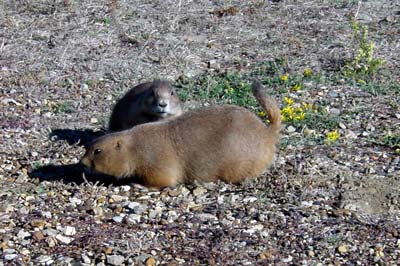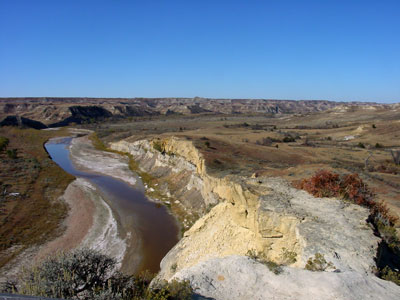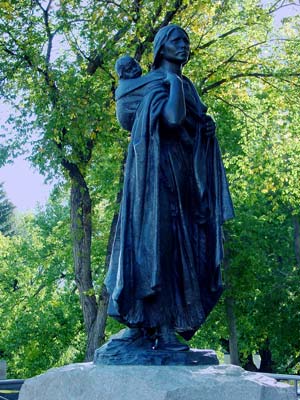
Across North Dakota
Oct. 4-5, 2003
We stopped at Theodore Roosevelt National Park in western North Dakota to see
what was there. The area is generally known as the Badlands. Teddy Roosevelt had
a ranch in this area. We took the scenic drive through the park and were
surprised at the size of the prairie dog towns (they are immense) and the number
of buffalo in the park. We got to see the buffalo up close and personal -
almost too close.

This buffalo, like most in the park, seemed to focus only on eating and almost completely ignored us as
we drove slowly by. They must be fattening themselves up for the coming winter.

The prairie dogs are little beggars and appear to be seeking handouts. If you
toss a stone towards them, they go for it as if it was food. There were numerous
signs asking people not to feed the prairie dogs, so they must be used to being
fed.

The North Dakota badlands. The river is the Little Missouri River; it has a
barely perceptible current, although we were told that it can be waist deep in
the spring. Why Teddy Roosevelt chose this area for a ranch, instead of
something like Jackson Hole or Estes Park, is beyond me. There is no accounting
for taste.

After Theodore Roosevelt National Park we headed for Bismarck to see some
Lewis and Clark sites we missed on the way west. The first stop was the
Sacagawea statue on the grounds of the North Dakota state capitol. The statue
shows her carrying her baby, Baptiste, who was nicknamed Pompey, or Pomp, by
Lewis and Clark.

Bismarck also has a replica of the keelboat used by Lewis and Clark. This keelboat was built by the same person that built the one in Onawa, IA. We missed that one, however, since it had been taken to the Iowa State Fair when we were there. This keelboat is said to be identical to the one in Iowa, except that it is on land, not in the water, and has a section cut out of the hull for people to walk on board. The Missouri river is n the background.